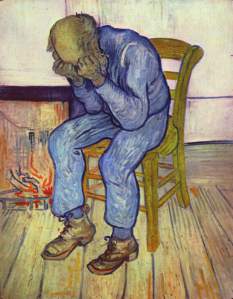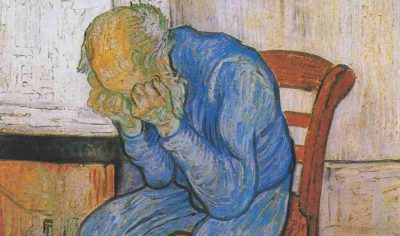Art of Japan and the Real Eternity’s Gate of Yuzo Saeki in the Mirror of Van Gogh
Lee Jay Walker
Modern Tokyo Times
Shortly before Van Gogh died he painted “At Eternity’s Gate” in 1890 after doing the same image as a lithograph eight years before. The image of this art piece is extremely powerful and the meaning can be transformed to mean many things. However, the initial impression during the first few moments of seeing this image conjures up thoughts related to despair, alienation, abandonment and a person who is at the end of their rope.
This reality connects the tragic demise of Yuzo Saeki but perhaps without an “Eternity’s Gate?” After all, Yuzo Saeki died in a strange land, isolated, confused and with his mind wandering from the desire to paint – while fighting so many health issues before “the gates of death” would take him from this world.
Yuzo Saeki, just like Van Gogh during his lifetime, experienced severe mental health problems during his final months on this earth. Therefore, this gifted artist from Japan died at the age of 30 because of multiple factors. This applies to having a nervous breakdown, tuberculosis that was eating away at his health, massive overwork, poverty, alienation from reality – and other factors that took away his life.
In this sense, “At Eternity’s Gate” by Van Gogh connects these two extremely gifted individuals. After all, if you replace the image with a 30-year-old man in a room more sinister and frightening and coughing up blood; then an image into the last moments of Yuzo Saeki can be seen through the art piece by Van Gogh. Equally disturbing is that Yuzo Saeki died in France where cultural differences in this period were enormous and when institutions were “more dark and foreboding” for people on the margins of society.
Therefore, Yuzo Saeki gradually slipped away from this world by being isolated, alienated, residing in destitution and with little care from others about his severe plight. In Japan, Yuzo Saeki had a family that was deeply concerned about the predicament he faced. However, his reality in the last few months must have been like Dante’s hell.
Van Gogh died at the age of 37 in 1890 while Yuzo Saeki was born eight years later in 1898. If “a tortured soul of a genius” could migrate and transcend itself into an equally “troubled soul” in the final year of his life, then it certainly entered Yuzo Saeki. Of course, many individuals reject heaven and hell and the transmigration of the soul. However, the utter despair of Yuzo Saeki during his remaining period on this earth in 1928 does mirror aspects of the painting “At Eternity’s Gate” by Van Gogh. The same also applies to the troubled mind of Van Gogh when “the demons of life” entered his world.
Michael Brenson (New York Times) states, “When European art began to question its own traditions, however, as it did increasingly during and after World War I, there was a potential for trouble. Artists could find themselves with neither a European tradition to learn from nor a Japanese tradition to hold onto. When Saeki Yuzo, who is perceived in his country as a tragic hero, the Japanese van Gogh, died at the age of 30 in an insane asylum in Paris in 1928 – perhaps a suicide – he had been trying to paint in this void. Saeki continues to be an example to Japanese artists abroad of the difficulties in reconciling East and West.”
Michael Brenson further comments, “His cafe windows and stores are filled with signs, some illegible. In his “Snowy Landscape,” figures are on the verge of illegibility. His signs seem like scars of an internal pressure to resolve a conflict between the independence and picturesque subject matter of Paris and a dependence upon his native calligraphic and woodcut tradition.”
Therefore, according to Michael Brenson, not even the death of Yuzo Saeki is one hundred percent known and this applies to what caused his death or if he killed himself. This fact brings back the image of “At Eternity’s Gate” but with the backdrop being more sinister and perhaps with Yuzo Saeki being shriveled up in the corner of a cold and dark room. After all, it appears that nobody in Paris really cared about how he died in the final moments of his life – and this is indeed sad.
Also, the image of “At Eternity’s Gate” shows an individual in despair and Yuzo Saeki certainly felt the same pains and abandonment. Not only this, were the signs illegible in some of the artwork by Yuzo Saeki based on him feeling alienated, rejected, and because he feared about upsetting local people? Or was it a natural sign that he felt trapped between two worlds, a natural aspect of his art, the fact that he could feel “the gates of death” – or did it signify his growing inward feeling that he didn’t belong within the environment that he cherished?
In an earlier article I wrote about Yuzo Saeki I comment that: “…despite all the artistic, political and cultural convulsions which befell Yuzo Saeki, along with suffering from tuberculosis, he still produced some truly amazing art. Therefore, the real tragedy of the life of Yuzo Saeki is that he didn’t have enough time to escape the trappings of two cultures that were pulling away at his artistic soul.”
Van Gogh also had an intense struggle between religion and rejection in several areas of his life – this in itself led to emotional instability. Given this, Van Gogh and Yuzo Saeki share internal convulsions because of different factors and both fully understood poverty, the strong feeling of alienation, rejection and the darkness of asylum institutions that further eroded the soul.
Therefore, the image of “At Eternity’s Gate” by Van Gogh enables people to enter “a small glimpse” into the world of two extremely talented individuals.
http://www.art.com/gallery/id–a228566/yuzo-saeki-posters.htm
http://www.nytimes.com/1987/12/25/arts/when-japan-s-art-opened-to-western-winds.html
http://www.artelino.com/articles/van_gogh_japonisme.asp
Modern Tokyo News is part of the Modern Tokyo Times group
DONATIONS to SUPPORT MODERN TOKYO TIMES – please pay PayPal and DONATE to sawakoart@gmail.com
http://moderntokyotimes.com Modern Tokyo Times – International News and Japan News
http://sawandjay.com Modern Tokyo Times – Fashion
https://moderntokyonews.com Modern Tokyo News – Tokyo News and International News
http://global-security-news.com Global Security News – Geopolitics and Terrorism
PLEASE JOIN ON TWITTER
https://twitter.com/MTT_News Modern Tokyo Times
PLEASE JOIN ON FACEBOOK
https://www.facebook.com/moderntokyotimes
Some Japanese art and cultural articles by Modern Tokyo Times are republished because of our growing international readership.





